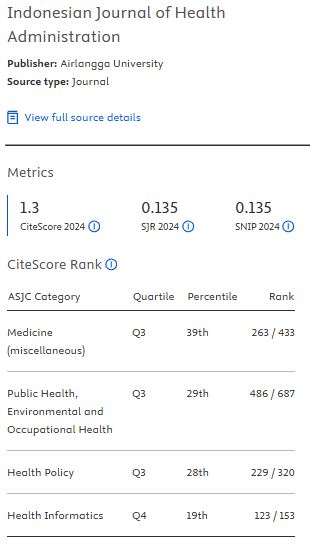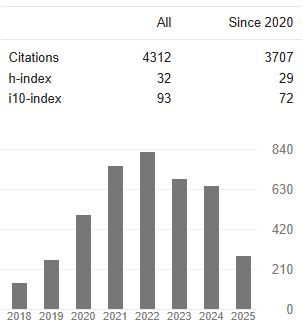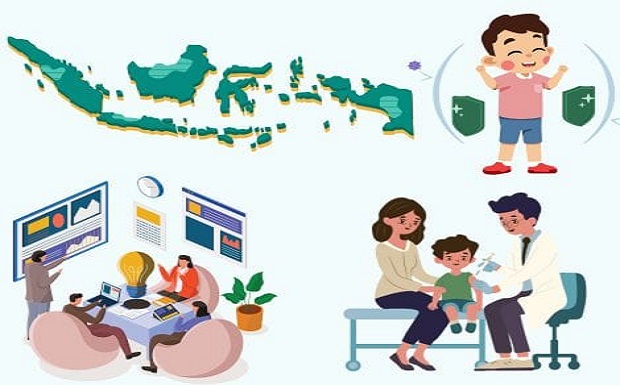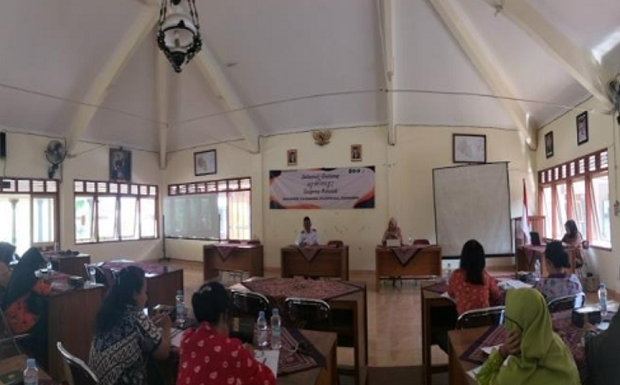THE HIDDEN ECONOMIC BURDEN OF LEPTOSPIROSIS: HEALTHCARE COSTS AND PATIENT IMPACT

Downloads
Background: Leptospirosis is a public health issue caused by the Leptospira bacterium, leading to significant economic impacts. The cost of illness due to Leptospirosis encompasses hidden costs that significantly affect individuals and society
Aims: This study aimed to assess the hidden economic burden (direct and indirect costs) experienced by patients and their families due to healthcare treatment of leptospirosis.
Methods: This descriptive cross-sectional study was conducted in Banyumas Regency from February to June 2024. Data were collected from patients who completed leptospirosis treatment in 2023. The variables of cost were categorized into direct treatment cost, treatment cost, and indirect cost, which were analyzed descriptively.
Results: Most leptospirosis patients were male, aged 26 – 45 years old, and the majority worked as farmers. Our study reveals that uninsured patients incurred higher out-of-pocket expenses during leptospirosis’ treatment. The productivity loss was estimated at USD 44.75, with significant hidden costs being transportation (USD 31.90), caregiver support (USD 86.38), and hospital treatment (USD 231.40).
Conclusion: The significant burden of Leptospirosis in Indonesia highlights the economic impact on individuals and the challenges within the healthcare system. This study calls for enhanced public health strategies focused on prevention, early diagnosis, and improved healthcare access to address the leptospirosis burden effectively.
Keywords: Cost of illness, economic burden, financial impact, leptospirosis, productivity loss
Agampodi, S., Gunarathna, S., Lee, J. S., et al. (2023) ‘Global, regional, and country-level cost of leptospirosis due to loss of productivity in humans’, PLoS Neglected Tropical Diseases, 17(8), pp. 1–11. doi: 10.1371/journal. and.0011291.
Badan Pusat Statistik (BPS) (2024) rata-rata-nilai-tukar-rupiah-terhadap-dollar-amerika-menurut-bulan. Available at: https://banyumaskab.bps.go.id/id/statistics-table/1/NzQyIzE=/rata-rata-nilai-tukar-rupiah-terhadap-dollar-amerika-menurut-bulan--2021---2023.html.
Badan Pusat Statistika (2024) ‘Persentase Penduduk yang Mengobati Sendiri Selama Sebulan Terakhir (Persen), 2020-2022’, (BPS - Statistics Indonesia), p. 1. Available at: https://www.bps.go.id/indicator/30/1974/1/persentase-penduduk-yang-mengobati-sendiri-selama-sebulan-terakhir.html.
Destanul Aulia, Sri Fajar Ayu, N. (2017) ‘Analisis Perbandingan Biaya Langsung (Direct Cost) dan Biaya Tidak Langsung (Indirect Cost) pada Pasien Stroke Di Rumah Sakit’, Jurnal Ekonomi Kesehatan Indonesia, 2(2), pp. 82–88. doi: 10.7454/eki.v2i2.2143.
Dhewantara, P. W., Riandi, M. U. and Wahono, T. (2022) ‘Effect of climate change on the geographical distribution of leptospirosis risk in western Java, Indonesia’, IOP Conference Series: Earth and Environmental Science, 1089(1). doi: 10.1088/1755-1315/1089/1/012074.
Drummond, M. F. et al. (2015) Methods for the Economic Evaluation of Health Care Programmes. 4th ed. Oxford: Oxford University Press.
Ehelepola, N. D. B., Ariyaratne, K. and Dissanayake, W. P. (2019) ‘The correlation between local weather and leptospirosis incidence in Kandy district, Sri Lanka from 2006 to 2015’, Global Health Action. Taylor & Francis, 12(1). doi: 10.1080/16549716.2018.1553283.
Eka Purnama, S. and Hartono, B. (2023) ‘Faktor Risiko Kejadian Leptospirosis Di Indonesia: Literature Review’, Prepotif : Jurnal Kesehatan Masyarakat, 6(3 SE-Articles), pp. 2010–2022. doi: 10.31004/prepotif.v6i3.8543.
Ferika Indrasari, Eleonora Maryeta Toyo, Siti Munawaroh, N. D. A. (2024) ‘View of Relationship Between Educational Level and Knowledge in Self-Medication of Diarrhea Disease Disease in Children.pdf’, Indonesian Journal of Global Health Research, 6(5), pp. 3031–3038. doi: https://doi.org/10.37287/ijghr.v6i5.3045.
Galan, D. I. et al. (2021) ‘Epidemiology of human leptospirosis in urban and rural areas of Brazil, 2000-2015’, PLoS ONE. doi: 10.1371/journal.pone.0247763.
Gasem, M. H. et al. (2020) ‘Leptospirosis in Indonesia: Diagnostic challenges associated with atypical clinical manifestations and limited laboratory capacity’, BMC Infectious Diseases. BMC Infectious Diseases, 20(1), pp. 1–11. doi: 10.1186/s12879-020-4903-5.
Hernandez-Rodriguez, P., Gómez, A. P. and Villamil, L. C. (2017) ‘Implications of urban and rural agricultural practices on the transmission of leptospirosis’, Agrociencia. Colegio de Postgraduados, 51(7), pp. 725–741.
Husni, S. H., Martini, M. and Suhartono, S. (2023) ‘Risk Factors Affecting the Incidence of Leptospirosis in Indonesia: Literature Review’, Jurnal Serambi Engineering, 8(1).
Ilma, K., Martini, M. and Raharjo, M. (2022) ‘Spatial Analysis And Risk Factors Of Leptospirosis In Indonesia. A Systematic Review’, Journal of Community Medicine and Public Health Research, 03(02), pp. 130–138. doi: 10.20473/jcmphr .v3i02.40660.
Jang, S. Y., Seon, J. Y. and Oh, I. H. (2020) ‘Influencing factors of transportation costs regarding healthcare service utilization in Korea’, Journal of Korean Medical Science, 35(35), pp. 1–14. doi: 10.3346/JKMS.2020.35.E290.
Kembhavi, R. S., Velhal, G. D. and Shah, A. K. (2021) ‘Epidemiological determinants of leptospirosis in rural and urban districts of Maharashtra, India.’, Journal of family medicine and primary care. India, 10(9), pp. 3361–3367. doi: 10.4103/jfmpc.jfmpc_674_21.
Kim, Y. E. et al. (2022) ‘DALY Estimation Approaches: Understanding and Using the Incidence-based Approach and the Prevalence-based Approach’, Journal of Preventive Medicine and Public Health, 55(1), pp. 10–18. doi: 10.3961/JPMPH.21.597.
Md-Lasim, A. et al. (2021) ‘Leptospirosis and coinfection: Should we be concerned?’, International Journal of Environmental Research and Public Health, 18(17). doi: 10.3390/ijerph18179411.
Munoz-Zanzi, C. et al. (2020) ‘A systematic literature review of leptospirosis outbreaks worldwide, 1970–2012’, Revista Panamericana de Salud Pública. SciELO Public Health, 44, p. e78.
Nugraheni, W. P. et al. (2024) ‘Economic Loss of Leptospirosis: Is It Still Appropriate to be Tropical Neglected Zoonosis Disease?’, Kesmas: Jurnal Kesehatan Masyarakat Nasional, 19(5), pp. 61–69. doi: 10.21109/kesmas.v19isp1.1098.
Petakh, P. et al. (2024) ‘Current treatment options for leptospirosis: a mini-review’, Frontiers in Microbiology, 15(April), pp. 1–9. doi: 10.3389/fmicb.2024.1403765.
Petrakovsky, J. et al. (2014) ‘Animal leptospirosis in Latin America and the Caribbean countries: reported outbreaks and literature review (2002–2014)’, International journal of environmental research and public health. MDPI, 11(10), pp. 10770–10789.
Rajapakse, S. (2022) ‘Leptospirosis: Clinical aspects’, Clinical Medicine, Journal of the Royal College of Physicians of London, 22(1), pp. 14–17. doi: 10.7861/clinmed.2021-0784.
Rauf, Z. et al. (2021) ‘Knowledge, attitudes, and families practices in selecting, obtaining, using, storing, and disposing of medicines on self-medication behavior in indonesia’, Open Access Macedonian Journal of Medical Sciences, 9(2015), pp. 1570–1577. doi: 10.3889/oamjms.2021.7700.
Sabermahani, A. et al. (2021) ‘Out-of-Pocket Costs and Importance of Nonmedical and Indirect Costs of Inpatients’, Value in Health Regional Issues. Elsevier Inc, 24, pp. 141–147. doi: 10.1016/j.vhri.2020.05.004.
Saizan, S. et al. (2019) ‘Economic benefit of leptospirosis prevention in Kelantan, Malaysia: Willingness-to-contribute approach’, The International Journal of Health Planning and Management, 34(1), pp. e817–e823. doi: https://doi.org/10.1002/hpm.2696.
Samina T. Syed, Ben S. Gerber, L. K. S. (2013) ‘Traveling Towards Disease: Transportation Barriers to Health Care Access’, Journal Community Health, 38(5), pp. 976–993. doi: 10.1007/s10900-013-9681-1.Traveling.
Sanhueza, J. M. et al. (2020) ‘Estimation of the burden of leptospirosis in New Zealand’, Zoonoses and Public Health, 67(2), pp. 167–176. doi: 10.1111/zph.12668.
Sriyani, S. et al. (2023) ‘Inundation Sewers and Mapping the Prevalence Leptospirosis Throughout Rats in Central Java Province’, Jurnal Penelitian Pendidikan IPA, 9(SpecialIssue), pp. 233–239.
Sukendra, D. M. et al. (2023) ‘Pyramid Pest-Control Community-Ecosystem-Management as an Effort to Prevent Leptospirosis’, Jurnal Abdimas, 27(2), pp. 219–225.
Sykes, J. E. et al. (2022) ‘Role of Diagnostics in Epidemiology, Management, Surveillance, and Control of Leptospirosis’, Pathogens, 11(4), pp. 1–24. doi: 10.3390/pathogens11040395.
Teles, A. J. et al. (2023) ‘Socio-geographical factors and vulnerability to leptospirosis in South Brazil’, BMC Public Health, 23(1), p. 1311. doi: 10.1186/s12889-023-16094-9.
Thomson, M. D. et al. (2023) ‘The many “costs” of transportation: Examining what cancer caregivers experience as transportation obstacles’, Cancer Medicine, 12(16), pp. 17356–17364. doi: 10.1002/cam4.6351.
Wang, F. et al. (2024) ‘Estimation of lifetime productivity loss from patients with chronic diseases: methods and empirical evidence of end-stage kidney disease from Taiwan’, Health Economics Review, 14(1), pp. 1–12. doi: 10.1186/s13561-024-00480-z.
Widawati, M. et al. (2023) ‘An investigation of geographical clusters of leptospirosis during the outbreak in Pangandaran, West Java, Indonesia’, Geospatial Health, 18(2).
Widowati, L. and Nurhayati (2017) ‘The Use of Traditional Health Care Among Indonesian Family’, Health Science Journal of Indonesia, 8(1), pp. 30–35. doi: 10.22435/hsji.v8i1.5600.Nurhayati.
Yuan, B., Zhang, T. and Li, J. (2022) ‘Family support and transport cost: understanding health service among older people from the perspective of social-ecological model’, Archives of Public Health. BioMed Central, 80(1), pp. 1–12. doi: 10.1186/s13690-022-00923-1.
Yuniasih, D. et al. (2022) ‘Systematic Review: Epidemiology Of Leptospirosis In Indonesia’, Jurnal Kesehatan Masyarakat. Fakultas Kesehatan Masyarakat Universitas Diponegoro, 10(5), pp. 544–549.
Copyright (c) 2025 Wahyu Pudji Nugraheni, Sinta Dewi Lestyoningrum, Indah Pawitaningtyas, Syarifah Nuraini, Linta Meyla Putri, Ristiyanto, Carine Milcent

This work is licensed under a Creative Commons Attribution-ShareAlike 4.0 International License.
1. As an author you (or your employer or institution) may do the following:
- make copies (print or electronic) of the article for your own personal use, including for your own classroom teaching use;
- make copies and distribute such copies (including through e-mail) of the article to research colleagues, for the personal use by such colleagues (but not commercially or systematically, e.g. via an e-mail list or list server);
- present the article at a meeting or conference and to distribute copies of the article to the delegates attending such meeting;
- for your employer, if the article is a ‘work for hire', made within the scope of your employment, your employer may use all or part of the information in the article for other intra-company use (e.g. training);
- retain patent and trademark rights and rights to any process, procedure, or article of manufacture described in the article;
- include the article in full or in part in a thesis or dissertation (provided that this is not to be published commercially);
- use the article or any part thereof in a printed compilation of your works, such as collected writings or lecture notes (subsequent to publication of the article in the journal); and prepare other derivative works, to extend the article into book-length form, or to otherwise re-use portions or excerpts in other works, with full acknowledgement of its original publication in the journal;
- may reproduce or authorize others to reproduce the article, material extracted from the article, or derivative works for the author's personal use or for company use, provided that the source and the copyright notice are indicated.
All copies, print or electronic, or other use of the paper or article must include the appropriate bibliographic citation for the article's publication in the journal.
2. Requests from third parties
Although authors are permitted to re-use all or portions of the article in other works, this does not include granting third-party requests for reprinting, republishing, or other types of re-use.
3. Author Online Use
- Personal Servers. Authors and/or their employers shall have the right to post the accepted version of articles pre-print version of the article, or revised personal version of the final text of the article (to reflect changes made in the peer review and editing process) on their own personal servers or the servers of their institutions or employers without permission from JAKI;
- Classroom or Internal Training Use. An author is expressly permitted to post any portion of the accepted version of his/her own articles on the author's personal web site or the servers of the author's institution or company in connection with the author's teaching, training, or work responsibilities, provided that the appropriate copyright, credit, and reuse notices appear prominently with the posted material. Examples of permitted uses are lecture materials, course packs, e-reserves, conference presentations, or in-house training courses;























